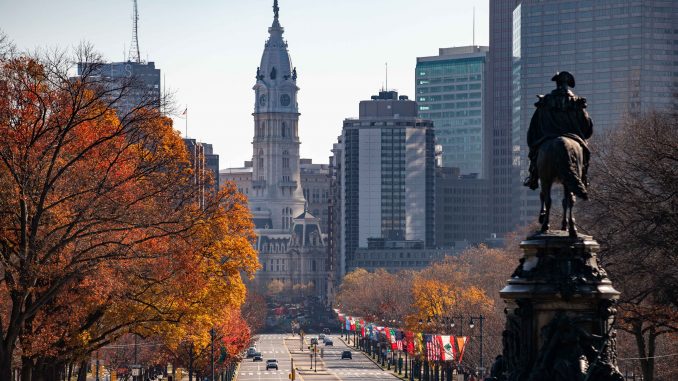
With thick masonry reminiscent of the French Second Empire style, a quick glance at Philadelphia’s City Hall can momentarily transport onlookers to Hôtel de Ville, the city hall of Paris, France.
Likewise, walking down the Benjamin Franklin Parkway to the Philadelphia Art Museum may feel like strolling the Avenue des Champs-Élysées in Paris toward the Arc de Triomphe.
These similarities are no mere coincidence, as strong French influences can be found everywhere in Philadelphia from its architecture to its art and food, according to a new book co-authored by two retired Temple University professors.
Lynn Miller, a professor emeritus of political science, and Therese Dolan, a professor emerita of art history, co-authored “Salut!: France Meets Philadelphia,” a book examining French influence on Philadelphia’s culture throughout its history. Published in December 2020 by Temple University Press, “Salut!” is a collection of five years of Miller and Dolan’s research and writing into the history and influence of France in the Philadelphia region, beginning in the colonial period and ending in the 19th century.
The book is available on Amazon, the Temple University Press website, The Barnes Foundation and other bookstores.
In addition to City Hall and Benjamin Franklin Parkway, French influence on architecture stretches to Cathedral Basilica of Saints Peter and Paul on Race Street near 18th and The Free Library of Philadelphia on Vine Street near 20th.
Barnes Foundation is home to French art, including post-impressionist paintings from French artist Pierre Auguste Renoir, and the Rodin Museum, which has the largest collection of French painter Auguste Rodin’s artwork outside of France.
Miller, who is the vice president of Alliance Fraçaise de Philadelphie, an organization focused on providing education of French language and culture, wanted to expand upon his 2007 book, ‘Philadelphie a la francaise’, which guides readers through locations of French influence in Philadelphia. He pitched the idea to Dolan, a board member of the organization, after a meeting about five years ago.
“We were at the elevator and he said, ‘Why don’t we write a book?’” Dolan said. “He said, ‘I’ll do the history and the architecture, and you do the art history.’”
Miller researched the history of French migration to the city and its influence on Philadelphia architecture and culture, while Dolan focused her studies on French artwork around the city and in museums. While Miller relied on secondary sources, creating a summary of research from books, journals and articles, Dolan leaned on primary sources to understand how both French and Philadelphia artists discussed their work in letters and journals and interviewed curators at the Philadelphia Museum of Art and the Rodin Museum to learn more about French art history in Philadelphia, she said.
“This has given me an opportunity to dig down into some things I sort of knew on the surface about French influence in the city,” Miller said. “From my standpoint, what’s been most interesting about it is that the influence is extremely varied.”
French influence in American art dates back to the colonial period, as French sculpture Jean Antoine Houdon created busts for George Washington, Benjamin Franklin and Thomas Jefferson, according to the Met museum.
In the mid-19th century, American artists who studied at the Pennsylvania Academy of the Fine Arts on Broad Street near Cherry were pushed to study in France because of the mastery found in the Louvre, an art museum in Paris, France and the annual salon, a place for artists to exhibit their work for government and wealthy people to purchase art, Dolan added.
This push led to a transformation in the art scene in the middle of the 19th century, which inspired artists like Thomas Eakins, a Philadelphia painter, to paint in a more European and French style that was not yet accepted in America, she said.
“[He] got fired because the nude in art in Europe is not shocking, but the prudishness of the American tradition is shocking,” Dolan added. “So when he undraped a female figure in class, he was fired from the academy. But he had great influence on others.”
Nancy Gabel, the president of Alliance Fraçaise de Philadelphie has worked with Miller and Dolan for years on French education, she said.
There is a long history of cultural, historical and artistic connection between Philadelphia and the Francophile world, which led to the founding of institutions like the Alliance Fraçaise de Philadelphie and the Ecole Fraçaise Internationale, which is the French International School in Philadelphia, Gabel said.
Through “Salut!,” Miller and Dolan used their expertise to emphasize Philadelphia’s French influences throughout history, examining cultural impacts when they occurred, she added.
“I know enough about what [Miller] and [Dolan’s] goals were with the book that it certainly has to be considered one of the most definitive work on the French connections in our city,” Gabel said. “I think the combination of the scholarly research of these two well-respected academics is a tremendous addition to our knowledge of Philadelphia.”
In addition to the Rodin Museum, the Philadelphia Museum of Art has a collection of French art and the Barnes Foundation features other French artists like Paul Cézanne and Henri Matisse, Gabel added.
“So many other aspects of Philadelphia culture are significantly connected with the Francophone portal, and I think this book has done a magnificent overview of the various aspects of Philadelphia that many people may not know,” she said.
With “Salut!,” Miller and Dolan aren’t trying to make the case that French influence is the most important cultural impact to Philadelphia history, architecture and art, but hope to showcase that it is unique to the city, Miller said.
“We are saying it’s distinctive, and it’s important, and you see it in all kinds of aspects of the life of the city,” he added. “That’s what we’ve found to be interesting.”



wonderful information !!!!